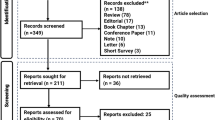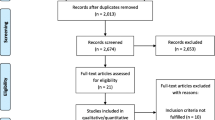Abstract
Occupational exposure to inhalational anesthetics has been associated with health problems, including reproductive issues. Considering the scarcity and outdated nature of reviews concerning this relevant topic, which has implications for indoor pollution/environmental science/public health, this critical review aimed to systematically evaluate whether exposure to inhalational anesthetics is associated with abortion. Seven databases were searched with no language or year restrictions. Of the 3881 search results, 18 observational studies were included. Some studies demonstrated a significant association between occupational exposure to inhalational anesthetics and spontaneous abortion, especially among professionals who work for longer periods and/or in an environment without gas scavenging/ventilation systems, which may favor the occurrence of abortion in this population. Due to considerable heterogeneity and limitations, it cannot be concluded whether an association exists between occupational exposure to anesthetics and the occurrence of abortion. However, more well-designed studies should be performed, especially in less economically developed countries that do not have access to quality anesthetic gas scavenging/ventilation systems, thereby bringing this issue into sharp focus. This review highlights the need for scientific knowledge in this area and the extensive use of scavenging equipment and in the workplace to minimize exposure and reduce the risk of abortion.

Similar content being viewed by others
Data availability
All data generated or analyzed during this study are included in this published article.
References
Allweiler SI, Kogan LR (2013) Inhalation anesthetics and the reproductive risk associated with occupational exposure among women working in veterinary anesthesia. Vet Anaesth Analg 40:285–289
Amma RO, Ravindran S, Koshy RC, Jagathnath Krishna KM (2016) A survey on the use of low flow anaesthesia and the choice of inhalational anaesthetic agents among anaesthesiologists of India. Indian J Anaesth 60:751–756
Axelsson G, Rylander R (1982) Exposure to anaesthetic gases and spontaneous abortion: response bias in a postal questionnaire study. Int J Epidemiol 11:250–256
Boivin JF (1997) Risk of spontaneous abortion in women occupationally exposed to anaesthetic gases: a meta-analysis. Occup Environ Med 54:541–548
Braz LG, Braz JRC, Cavalcante GAS, Souza KM, Lucio LMC, Braz MG (2017) Comparison of waste anesthetic gases in operating rooms with or without an scavenging system in a Brazilian University Hospital. Rev Bras Anestesiol 67:516–520
Braz MG, Souza KM, Lucio LMC, di Renzo GCC, Feliciano LM, Marcondes JPC, Chen CYO, Braz JRC, Braz LG (2018) Detrimental effects detected in exfoliated buccal cells from anesthesiology medical residents occupationally exposed to inhalation anesthetics: an observational study. Mutat Res 832-833:61–64
Braz MG, Carvalho LIM, Chen CO et al (2020) High concentrations of waste anesthetic gases induce genetic damage and inflammation in physicians exposed for three years: a cross-sectional study. Indoor Air 30:512–520
Burgoyne PS, Holland K, Stephens R (1991) Incidence of numerical chromosome anomalies in human pregnancy estimation from induced and spontaneous abortion data. Hum Reprod 6:555–565
Chandrasekhar M, Rekhadevi PV, Sailaja N, Rahman MF, Reddy JP, Mahboob M, Grover P (2006) Evaluation of genetic damage in operating room personnel exposed to anaesthetic gases. Mutagenesis 21:249–254
Chaoul MM, Braz JR, Lucio LM, Golim MA, Braz LG, Braz MG (2015) Does occupational exposure to anesthetic gases lead to increase of pro-inflammatory cytokines? Inflamm Res 64:939–942
Cohen EN, Bellville JW, Brown BW Jr (1971) Anesthesia, pregnancy and miscarriage: a study of operating room nurses and anesthetists. Anesthesiology 35:343–347
Cohen E, Brown BW, Bruce DL et al (1974) Occupational disease among operating room personnel: a national study. Anesthesiology 41:321–340
Cohen EN, Gift HC, Brown BW et al (1980) Occupational disease in dentistry and chronic exposure to trace anesthetic gases. J Am Dent Assoc 101:21–31
El-Ebiary AA, Abuelfadl AA, Sarhan NI, Othman MM (2013) Assessment of genotoxicity risk in operation room personnel by the alkaline comet assay. Hum Exp Toxicol 32:563–570
Ericson HA, Källén AJB (1985) Hospitalization for miscarriage and delivery outcome among Swedish nurses working in operating rooms 1973-1978. Anesth Analg 64:981–988
Figà-Talamanca I (2000) Reproductive problems among women health care workers: epidemiologic evidence and preventive strategies. Epidemiol Rev 22:249–260
Guirguis SS, Pelmear PL, Roy ML, Wong L (1990) Health effects associated with exposure to anaesthetic gases in Ontario hospital personnel. Occup Environ Med 47:490–497
Heidam LZ (1984) Spontaneous abortions among dental assistants, factory workers, painters, and gardening workers: a follow up study. J Epidemiol Community Health 38:149–155
Izdes S, Sardas S, Kadioglu E, Karakaya AE (2010) DNA damage, glutathione, and total antioxidant capacity in anesthesia nurses. Arch Environ Occup Health 65:211–217
Kargar Shouroki F, Neghab M, Mozdarani H, Alipour H, Yousefinejad S, Fardid R (2019) Genotoxicity of inhalational anesthetics and its relationship with the polymorphisms of GSTT1, GSTM1, and GSTP1 genes. Environ Sci Pollut Res Int 26:3530–3541
Knill-Jones RP, Rodrigues LV, Moir DD, Spence AA (1972) Anaesthetic practice and pregnancy. Controlled survey of women anaesthetists in the United Kingdom. Lancet 1:1326–1328
Lauwerys R, Siddons M, Misson CB, Borlee I, Bouckaert A, Lechat MF, de Temmerman P (1981) Anaesthetic health hazards among Belgian nurses and physicians. Int Arch Occup Environ Health 48:195–203
Lindbohm ML, Taskinen H (2000) Spontaneous abortions among veterinarians. Scand J Work Environ Health 26:501–506
Lucio LMC, Braz MG, do Nascimento Junior P, Braz JRC, Braz LG (2018) Occupational hazards, DNA damage, and oxidative stress on exposure to waste anesthetic gases. Rev Bras Anestesiol 68:33–41
Mirakhur RK, Badve AV (1975) Pregnancy and anaesthetic practice in India. Anaesthesia 30:18–22
Moher D, Shamseer L, Clarke M et al (2015) Preferred reporting items for systematic review and meta-analysis protocols (PRISMA-P) 2015 statement. Syst Rev 4:1
Munn Z, Moola S, Lisy K, Riitano D, Tufanaru C (2015) Methodological guidance for systematic reviews of observational epidemiological studies reporting prevalence and cumulative incidence data. Int J Evid Based Healthc 213:147–153
Nagella AB, Ravishankar M, Hemanth Kumar VR (2015) Anaesthesia practice and reproductive outcomes: facts unveiled. Indian J Anaesth 59:706–714
National Institute for Occupational Safety and Health (NIOSH). Criteria for a recommended standard: occupational exposure to waste anesthetic gases and vapors. 1977. Department of Health, Education, and Welfare, Public Health Service, Center for Disease Control
Nilsson R, Björdal C, Andersson M, Björdal J, Nyberg A, Welin B, Willman A (2005) Health risks and occupational exposure to volatile anaesthetics – a review with a systematic approach. J Clin Nurs 14:173–186
Nybo Andersen AM, Wohlfahrt J, Christens P, Olsen J, Melbye M (2000) Maternal age and fetal loss: population based register linkage study. BMJ 320:1708–1712
Pharoah PO, Alberman E, Doyle P, Chamberlain G (1977) Outcome of pregnancy among women in anaesthetic practice. Lancet 1:34–36
Quansah R, Jaakkola JJ (2010) Occupational exposures and adverse pregnancy outcomes among nurses: a systematic review and meta-analysis. J Women's Health (Larchmt) 19:1851–1862
Rosenberg P, Kirves A (1973) Miscarriages among operating theatre staff. Acta Anaesthesiol Scand 18:37–42
Rosenberg PH, Vänttinen H (1978) Occupational hazards to reproduction and health in anaesthetists and paediatricians. Acta Anaesthesiol Scand 22:202–207
Rowland AS, Baird DD, Weinberg CR, Shore DL, Shy CM, Wilcox AJ (1992) Reduced fertility among women employed as dental assistants exposed to high levels of nitrous oxide. N Engl J Med 327:993–997
Rowland AS, Baird DD, Shore DL, Weinberg CR, Savitz DA, Wilcox AJ (1995) Nitrous oxide and spontaneous abortion in female dental assistants. Am J Epidemiol 141:531–538
Saurel-Cubizolles MJ, Hays M, Estryn-Behar M (1994) Work in operating rooms and pregnancy outcome among nurses. Int Arch Occup Environ Health 66:235–241
Schenker MB, Samuels SJ, Green RS, Wiggins P (1990) Adverse reproductive outcomes among female veterinarians. Am J Epidemiol 132:96–106
Shaker DA, Samir AM, Hagag HA, Abd El-Aal AA, Afify RA (2011) Cytogenetic damage in operating room nurses exposed to anesthetic gases. Med J Cairo Univ 79:237–244
Sharma A, Bhatia P, Vyas V, Sethi P, Kaloria N, Sharma L (2019) Should total intravenous anesthesia be used to prevent the occupational waste anesthetic gas exposure of pregnant women in operating rooms? Anesth Analg 128:188–190
Shirangi A, Fritschi L, Holman CDJ (2009) Associations of unscavenged anesthetic gases and long working hours with preterm delivery in female veterinarians. Obstet Gynecol 113:1008–1017
Souza KM, Braz LG, Nogueira FR, Souza MB, Bincoleto LF, Aun AG, Corrente JE, Carvalho LR, Braz JRC, Braz MG (2016) Occupational exposure to anesthetics leads to genomic instability, cytotoxicity and proliferative changes. Mutat Res 791-792:42–48
Vaĭsman AI (1967) Working conditions in the operating room and their effect on the health of anesthetists. Eksp Khir Anesteziol 12:44–49
Warembourg C, Cordier S, Garlantézec R (2017) An update systematic review of fetal death, congenital anomalies, and fertility disorders among health care workers. Am J Ind Med 60:578–590
Acknowledgments
The authors would like to thank Marluci Betini for her help during the search strategy.
Funding
LAO received a fellowship (#129769/2016-9) from the National Council for Scientific and Technological Development (CNPq), Brazil.
Author information
Authors and Affiliations
Contributions
MGB, RPED, and LGB designed the study; LAO and MGB performed the searches and screened studies for eligibility; LAO and DBSF extracted the data; LGB, DBSF, and MGB assessed the quality of the papers; LAO and MGB drafted the manuscript; and LGB critically revised the manuscript. All authors approved the final version.
Corresponding author
Ethics declarations
Competing interests
The authors declare that they have no competing interests.
Ethical approval
Not applicable (there was no need for ethical approval due to the type of study, i.e., a systematic review).
Consent to participate
Not applicable.
Consent to publish
Not applicable.
Additional information
Responsible Editor: Lotfi Aleya
Publisher’s note
Springer Nature remains neutral with regard to jurisdictional claims in published maps and institutional affiliations.
Supplementary information
Supplementary information may be found online.
ESM 1
(DOCX 20 kb)
Rights and permissions
About this article
Cite this article
Oliveira, L.A., P. El Dib, R., Figueiredo, D.B.S. et al. Spontaneous abortion in women occupationally exposed to inhalational anesthetics: a critical systematic review. Environ Sci Pollut Res 28, 10436–10449 (2021). https://doi.org/10.1007/s11356-020-11684-1
Received:
Accepted:
Published:
Issue Date:
DOI: https://doi.org/10.1007/s11356-020-11684-1




